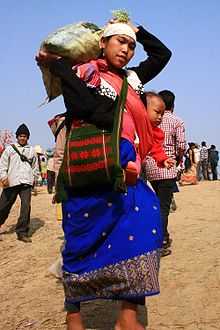Jonbeel Mela
| Joonbeel Mela | |
|---|---|
| Date(s) | January or February |
| Frequency | annual |
| Location(s) |
Dayang Belguri Marigaon, Assam |
| Inaugurated | 15th century AD |
Joonbeel Mela (pron:ˈʤɒnˌbi:l ˈmeɪlə) (Assamese: জোনবিল মেলা) is a three-day community fair held the weekend of Magh Bihu at a historic place known as Dayang Belguri at Joonbeel. It is 5 km from Jagiroad in Marigaon district of Assam[1][2][3][4] and 32 km from Guwahati. The National Highway connecting the mela is NH 37.[2][4] The Joonbeel (Joon and Beel are Assamese terms for the Moon and a wetland respectively) is so called because a large natural water body is shaped like a crescent moon.[1]

History
The mela is said to be begun not later than 15th century AD.[1] It was first organized ago by the Ahom kings to discuss the prevailing political situations.[5]

Barter system
During the occasion a huge bazaar is held. A few days before the mela starts, communities and tribes like Karbi, Khasi, Tiwa, and Jayantia of the northeast come down from the hills with products and interchange their merchandise with the local people in a barter system.[2][3][4] It is said to be a hi-tech age barter system and perhaps the only fair in India where barter system is still alive.[1][3][4]

Significance
Before the mela takes place, an Agni Puja (fire worship) is performed for the well-being of the mankind[2][3][4] The mela starts with community fishing in the Joonbeel wetland.

The theme of the mela is harmony and brotherhood among the tribes and communities scattered in the Northeast India. The Gobha King along with his courtiers visits the mela and collects taxes from his subjects.[3][4] People perform their traditional dance and music, making the atmosphere one of joy and fun.[2][4]
Royal allowance
On January 17, 2009 the Government of Assam announced an “Annual Royal Allowance” for the 19 customary kings from communities under the Gobha Kingdom that includes parts of three districts of present Assam: Morigaon, Nagaon and Kamrup. The Education Minister of Assam, Gautam Bora, distributing the bank cheques among the kings, said that the monetary assistance will be something between Rs. 3000 to Rs. 10,000 depending on the population count under them.[5]
Reactions
Expressing their great delight at the initiative taken by the government the kings welcomed the move.[5]
- Gobha King Deep Sing said, “It is a welcome move by the government of Assam. We have been demanding this for a long time as the economic condition of all these customary kings is going down. If we do not receive any assistance from the government, it would be difficult to maintain even the tradition of hosting the annual Joonbeel Mela, which has become an important tourist destination."
- Ahom King Susenfa Pratap Singha had said, "The Mela was initiated by our predecessors to maintain cordial relations among all communities. The government assistance would help to fulfil the predecessors' dreams.”
In fiction
There is an elaborate references of the mela in Rita Chowdhury's Sahitya Akademy Award-winning novel Deo Langkhui.[6]
References
- ↑ 1.0 1.1 1.2 1.3 Borthakur, Dibya Jyoti (January 19, 2008). "Jonbeel Mela drawing a large number of visitors". Assam Times. Retrieved 2009-10-23.
- ↑ 2.0 2.1 2.2 2.3 2.4 "Jonbeel Mela". Retrieved 2009-10-23.
- ↑ 3.0 3.1 3.2 3.3 3.4 "Assam Fairs & Festivals". 121indiatourism.com. Retrieved 2009-10-23.
- ↑ 4.0 4.1 4.2 4.3 4.4 4.5 4.6 "Joonbeel Mela – Assam". Indiawijzer.nl. Retrieved 2009-10-23.
- ↑ 5.0 5.1 5.2 Sharma, Anup (January 18, 2009). "JONBEEL FAIR - Royal allowance for Kings of Assam". Sakaltimes.com. Retrieved 2009-10-23.
- ↑ Saikia, Samiran. "Between the lines". Retrieved 2009-10-23.
External links
| ||||||||||